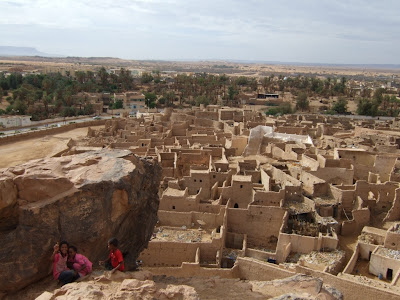In summer the only significant breeding gull in Libya is the yellow-legged gull. This breeds mostly in north east Libya. Similarly the main breeding tern is the lesser crested tern which also breeds in north east Libya. There are also small breeding colonies of little tern all across the Libyan coast and an even smaller breeding group of Caspian tern on the coastal border with Tunisia.
This situation changes radically in winter. There is a big influx of wintering gulls and in turn the lesser crested tern mostly migrates south.
slender-billed gull, Ain Azziana October 30
In north east Libya (Cyrenaica) the two biggest groups of wintering gulls are black-headed gull and slender-billed gull. They have been arriving gradually over the past two or three weeks.
When we were at Ain Azziana over the weekend there were a mixture of local yellow-legged gull and wintering slender-billed gull.
black-headed gulls, New Benghazi, October 28
Black- headed gull will venture in-land. Above is a group seen next to my house in urban Benghazi.
whiskered tern, Juliana, October 30
Just as lesser crested tern have left, the wetlands around Benghazi all have sizeable numbers of whiskered tern. Again (like the gulls) they have arrived over the past two or three weeks. Unlike most whiskered tern who pass through other countries and winter south of the Sahara these birds will stay.
I know that Andy and Helen were as impressed as I was at the show these birds put on while feeding.
By the way Andy writes his own travel blog called "two drifters off to see the world" http://andyparkin.wordpress.com/ I recommend a visit to his site. Andy promises he will write up about his visit to Benghazi.
whiskered tern, Juliana, October 30
So what happens to the lesser crested tern in winter?
Here is part of a very recent email message to the Egyptian Birding Group from Libyan expert Abdulmaula Hamsa who is writing a PhD on the bird
In Libya there is three breeding sites for Lesser crested terns Sterna (Thalasseus) bengalensis,those are Elba island (Jaziret Al Elba 32°13' N; 23°18'E) which is the closest to Egyptian border with in the historic Bumbah bay, and the breeding population here is about 60-80 adults, the second is Gara island (30°48' N 19°54'E) where 1500-2000 pairs breed each summer, and lastly Jeliana islet in Benghazi 32° 05 N 20°03E) which is an inshore site, and 200-300 terns breed.
Here is part of a very recent email message to the Egyptian Birding Group from Libyan expert Abdulmaula Hamsa who is writing a PhD on the bird
In Libya there is three breeding sites for Lesser crested terns Sterna (Thalasseus) bengalensis,those are Elba island (Jaziret Al Elba 32°13' N; 23°18'E) which is the closest to Egyptian border with in the historic Bumbah bay, and the breeding population here is about 60-80 adults, the second is Gara island (30°48' N 19°54'E) where 1500-2000 pairs breed each summer, and lastly Jeliana islet in Benghazi 32° 05 N 20°03E) which is an inshore site, and 200-300 terns breed.
So far the chicks of this species were ringed in seasons from 2006-2010, mainly with metal rings donated by Birdlife Malta and color (bi character rings) from Italy. you can see more on our ringing scheme at http://home.scarlet.be/~pin02658/cr-Lesser%20Crested%20Tern.htm
So far we had some good number of resightings and recoveries from both Benghazi and Gara sites in Northwest and west Africa, amazingly non of the birds rings in Elba (the most easter site) were sighted or recovered anywhere.
I believe that Elba birds may head east not west as other terns from Gara and Benghazi sites, and mix with huge population of the Red Sea. I am appealing to you to have a closer look whenever possible on little legs of these birds during April-June and during September-November on the mediterranean coast of Egypt and along the whole year at Red Sea sites. These birds usually associated with Sandwich terns and other crested tern species.
So it looks like most lesser crested tern go to west Africa and the others to the Red Sea. I will keep the blog informed as when we find out for sure.















































